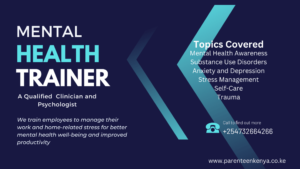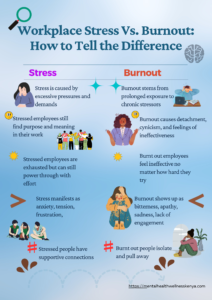If you are like most people, you’ve probably experienced days of frustration, exhaustion, or feeling overwhelmed at work.
You push through constant demands and deadlines, handle difficult coworkers or bosses, and deal with workplace politics day after day.
Were you able to differentiate if your experiences stemmed from manageable workplace stress or true burnout?
Understanding the differences between stress and burnout, and identifying the early warning signs, is key for employees and employers to prevent decreased productivity, increased mental health challenges, and other negative consequences.
In the next section, we will discuss workplace stress and burnout separately and explain their signs and symptoms. We will then differentiate the two and suggest ways to overcome them.
What is Workplace Stress?

Workplace stress refers to the harmful physical and emotional responses that occur when the requirements of a job do not match the capabilities, resources, or needs of the employee. Stress can be triggered by:
- Excess work
- Lack of work or boredom
- A poor organizational culture
- Unrealistic expectations
- Long hours
- Lack of work-life balance
- Office politics and conflict
- Lack of autonomy or control
- Difficult coworkers or bosses
- Job insecurity
It can make employees feel frustrated, irritated, overwhelmed, depressed, or anxious. If stress persists for too long without relief, it can impact both mental and physical health.
Signs of Workplace Stress
Depending on the type of work, a person's mental strength, and how long the stressor has been around, employees manifest signs of workplace stress at different times.
The following table outlines the common signs and symptoms that indicate an employee is experiencing unhealthy stress levels related to their job.
| Category | Signs of Workplace Stress |
| Physical | Fatigue, insomnia, headaches, stomach issues, weight changes, heart palpitations, teeth grinding, muscle tension, pain, and suppressed immune system |
| Emotional/Mental | Irritability, moodiness, sadness, depression, anxiety, lack of focus, disorganization, memory issues, inability to concentrate, indecision, lack of motivation, and feelings of burnout |
| Behavioral | Changes in appetite, procrastination, interpersonal conflict, crying, substance or alcohol abuse, panic attacks, and throwing objects |
| Occupational | Arriving late or leaving early, taking many sick days, making mistakes, having accidents, facing disciplinary action, decreased productivity and quality of work |
There is no definitive timeframe for when signs of workplace stress will manifest, as it depends on the individual and their specific situation.
However, in acute workplace stress situations, such as a sudden increased workload or intense deadline, signs may start to show up within days or weeks.
When there are chronic stressors, like an unhealthy work environment or long hours, it often takes about 1-3 months for physical or mental strain to accumulate and lead to noticeable symptoms.
While some occupational indicators, like making errors or missing deadlines, may arise quickly, signs of chronic workplace stress typically emerge slowly over months or years of unending pressures.
This accumulative stress leads to health problems, absenteeism, fatigue, anxiety, low engagement, and negativity.

What is Workplace Burnout?
Workplace burnout occurs after prolonged exposure to chronic stress from interactions with others at work. It is characterized by:
- Overwhelming exhaustion
- Feelings of cynicism
- Detachment from work
- Sense of ineffectiveness
- Lack of accomplishment
While normal workplace stress can be managed if properly handled, burnout refers to a chronic state when stressful conditions persist uninterrupted for too long.
As an employee, when you feel you lack adequate coping resources and control over stressful work demands, it can lead to a breakdown and the eventual emotional, mental, and physical exhaustion of burnout.
Signs of Workplace Burnout

When someone is experiencing burnout at work, they often start having negative attitudes toward their coworkers, managers, or customers. Where they once cared about people, they may now feel detached, distrustful, aggressive, or apathetic.
On a personal level, the employee still feels exhausted despite trying their best to keep up with work. You may struggle with:
- Extreme tiredness
- Sleep troubles
- Anxiety
- Sadness
- Moodiness
- Lack of motivation
No matter how hard you work, you feel ineffective since you can’t do your job well anymore. Other common signs include:
- Pulling away from job duties
- Isolating from colleagues
- Headaches
- Stomach problems
- Using alcohol or drugs to cope
- Shortened attention span
- Taking many sick days due to burnout.
Overall, a stressed-out employee who was once engaged starts disconnecting from their work and losing their ability to relate to others. This points to advanced burnout. They start doubting their abilities, making it difficult for them to function or contribute meaningfully.

How to Tell the Difference
Hekima’s Story
Hekima was promoted to senior marketing manager, taking on responsibility for several large client accounts. Though proud of her promotion, she found the workload overwhelming. Hekima had anxiety about work most evenings and weekends, frequently working 12+ hour days and still falling behind. The nonstop demands resulted in chronic tension headaches, back pain, and disrupted sleep, leaving Hekima exhausted.
While Hekima's manager complimented her performance at the 6-month mark, the pace was grueling. Hekima doubted she could continue working at this level for another six months without negative health or personal life consequences.
Tom’s Story
After years of constantly working 70+ hour weeks as a top financial analyst at his investment bank, Tom began feeling bitter that his dedication was not leading to the partnership-level promotion he long desired. The long hours worsened his chronic lower back pain despite medical treatment. His kids complained that they hardly see him.
Feeling underappreciated, exhausted, and ineffective, Tom became sarcastic toward younger analysts and dragged his feet on a major client report. He stopped caring about quality and was late submitting a high-profile analysis due to staying at a bar past midnight several weeknights.
The Distinction
While both Hekima and Tom exhibit physical symptoms and emotional strain from intense work demands, Hekima displays signs of manageable workplace stress, whereas Tom has clearly progressed to full burnout syndrome.
We see Hekima pushed hard and increasingly anxious under mounting responsibilities but still succeeding in her job, taking pride in her accomplishments, having supportive connections, and hoping she will adapt to the strain.
Conversely, Tom harbors bitterness about inadequate rewards for years of extreme hours, stops taking pride in quality work, and has descended into negativity and indifference, blatantly neglecting responsibilities.
Hekima feels exhausted but committed to powering through. Tom feels ineffective and has given up trying his best.
Hekima still finds gratification in achievements, whereas Tom sees no purpose or positive outcomes from continually giving everything.
While both situations highlight unhealthy work expectations, Hekima retains some protective factors like connections and hope while Tom exhibits the key dimensions of burnout— exhaustion, negativity, and ineffectiveness after prolonged exposure to unsustainable stressors.
What Next: Overcoming Workplace Stress and Burnout

Now that we've explored the significant differences between manageable workplace stress and debilitating burnout syndrome, what can you do to overcome these issues and promote a healthier work environment? Here are a few suggestions:
- Be self-aware by monitoring yourself for early signs like exhaustion, anxiety, aches, or constant negativity.
- Prioritize sleep, nutrition, and exercise.
- Take regular breaks and use your leave days to rest.
- Tap social support by talking to trustworthy colleagues who relate to your experience.
- Take time to pray about your work situation, meditate on God's word, and appreciate the little things.
- Reframe thoughts by stopping negative cycles and adjusting a perfectionistic mindset.
- Enhance time management skills by using calendar blocking and productivity tools.
- Speak up openly by communicating with managers when work feels truly unmanageable.
While you can make impactful changes to improve your mental health, organizations must also provide the proper resources, workloads, staffing levels, culture, leadership behavior, and flexibility needed to support sustainable productivity.
Mental Health Wellness Kenya comes in to address these challenges and help organizational leadership see how some policies and programs lead to more mental health challenges leading to reduced productivity and high job turnover.
We also offer group therapy and one-on-one counseling to help employees overcome workplace stress and burnout. Reach out to us today and let's help you enjoy a more fulfilling work life.
Images by Pexel and Unsplash

